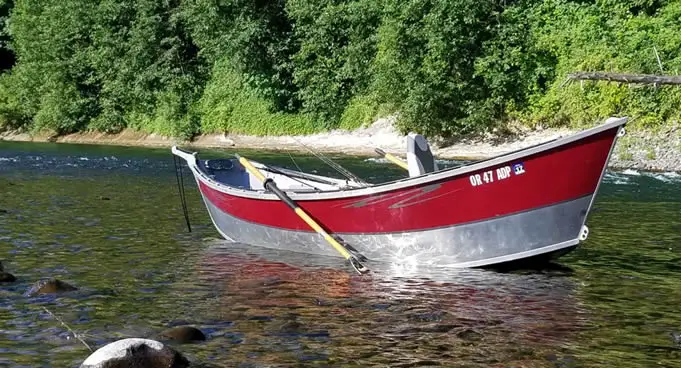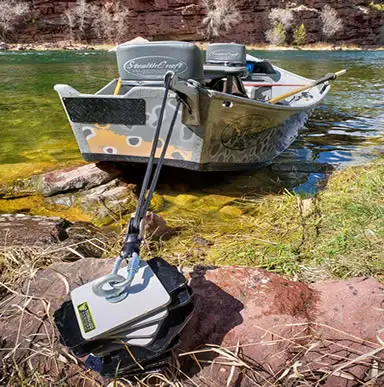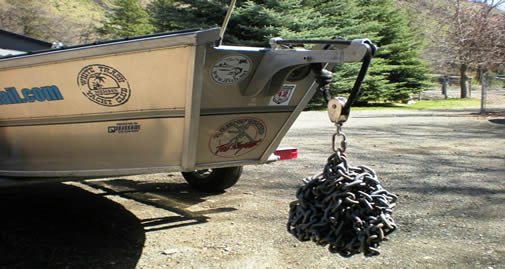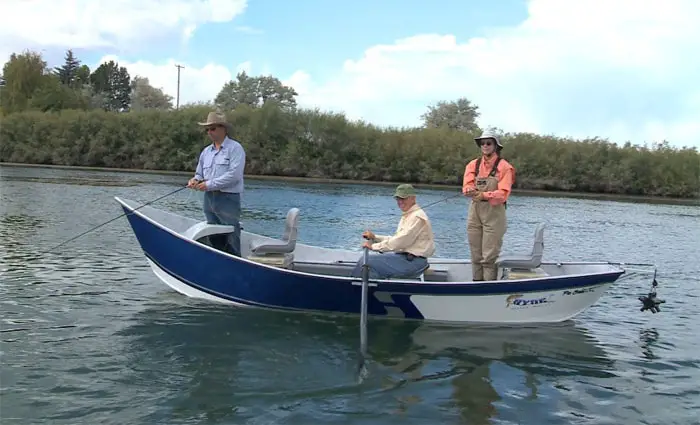Contents
How To Anchor A Drift Boat
Slow dropping of a front anchor on a drift boat is advised for fishing.
When parking at an eddy, you should drop a rear anchor fast so the boat stops fast and holds its position.

Front and rear anchors can have different setups.
If the boat is fitted with a motor you need to use a side pulley system to drop and raise the anchor so it clears the motor and can be operated from the rower seat.
Don’t tie a knot at the end of the line in case you need to release the anchor for safety reasons.
How To Use A Rear Or Front Drift Boat Anchor
Using a rear drift boat anchor
When river drifting it is better to have your anchor at the back of the boat as this allows you to raise it quickly.
It also lets you get to the oars quickly which is vital when your are in fast water or when there are nearby obstructions you need to avoid.
If your drift boat is fitted with a motor (be sure to read our advice on the type and size of motor to use and follow our instructions for mounting it) then you will need to mount an appropriate anchor pulley so the anchor clears the motor and is easy to access.
Wen using a pulley system be sure to keep in mind that having a side pull anchor system that allows the oarsman to raise the anchor from the rower seat is very advantageous.
Using a front drift boat anchor
There are times when a front anchor is better.
Anchoring at the front is the best option for fishing.
An anchor at the front is also very useful in certain marine environments such as lakes and tidewater for example.
Anchoring with both front & rear drift boat anchors
Some drift boat owners will keep an anchor at the front for fishing and a fast-hold anchor at the back for river running.
Anchoring the boat with both a front and rear anchor at the same time will stop the boat from swinging which can be helpful when fishing.
Just be aware that using both a front and rear anchor will increase the weight on your boat.
The correct procedure for handling the anchor line/rope
Do you hold the anchor rope or let it loose?
You will know if you need to to hold on to the rope when you lower the anchor, in order to let it down smoothly, or if you need to simply drop the anchor, by the water you are in.
Sometimes it is a good idea to let the anchor down slowly when you are in slow, fish abundant, water.
Other times you will want to drop the anchor without holding the rope as you will want the anchor to hold the boat fast and without dragging.
So when you are in a situation where you need your drift boat to stop quickly and hold fast you will want to drop the anchor without holding the line.
What to do when the boat drags after dropping the anchor
As we cover below the holding power, and the speed at which the anchor holds, is largely dependent on your anchor setup.
However, sometimes the holding power of the anchor is dependent on the length of the line let out.
If you find your boat is dragging after you have dropped the anchor try letting out more line until it holds.
There are times when you do not want to rely on this method however, for example when you want to park at the last eddy before a bend.
In instances when you need your drift boat to stop fast and hold fast you need to use an anchor designed to hold fast without dragging.
We cover that in detail later in this article.
Pros & Cons Of Using A Side Or Foot Anchor Release
Should you use a side or foot anchor release?
Some drift boat owners use a side pulley system for the anchors while others prefer a foot release system.
There are a few advantages and drawbacks to using both systems.
Let’s take a look at them now.
Pros and cons of using a foot release
Obviously using a foot anchor release system makes dropping and raising the anchor effortless.
However, it also comes with two drawbacks.
Firstly, the line inside the PVC pipe can freeze in cold weather conditions and it can be a pain to get the release mechanism working before you hit the water.

For some people who live in areas that don’t experience very cold conditions, or they simply don’t take to the water in those conditions, this is not a problem.
For those of us who do, it can be a bit of a recurring pain.
Secondly, not all of us are of nimble feet.
Dare I say some of us may even be considered slightly clumsy?!
So be aware that having an anchor release right beside your foot can result in a lowering of the anchor at the most inopportune times!
Pros and cons of using a side release
A side pulley system is much more common so you have a lot of choice, it’s cheaper and it’s pretty much maintenance-free.
However, a side pulley anchor system also has some drawbacks.
A side pulley system requires more effort than the foot release.
But more than that, it also comes with some hidden dangers.
When dropping the drift boat anchor fast you must ensure that the anchor rope has not picked up some lose flies, which is more common than you might think.
Lose flies that attach themselves to the anchor rope will catch on your hands as you lower the rope.
This can be extremely painful.
Of course there are “easy pull” side pulley drift boat anchor systems available.
Many people will opt for this “easy pull” system and this, although great for reducing the manual effort associated with anchoring, also comes with its on challenges.
Most of the easy pull systems available will tend to spin at times and when this happens you have wait for the anchor to unwind so you can renew your efforts to haul it up.
They also have twice the amount of rope as a standard system so you have to do twice the work (albeit it’s a lot easier).
As you can see there are advantages and disadvantages to using a pulley system and a foot release system.
It’s really a matter of personal preference whether you want a side pulley system or a foot release system.
How To Setup The Anchor For Use
The most important part of anchoring a drift boat is having your anchor system set up correctly.
As you will see this is most important on a drift boat that is used for river running.
When putting an anchor system on your drift boat you will first want to consider what you use the boat for.
For fishing, a different drift boat anchor setup is used, from an anchor setup for river running.
If your drift boat is fitted with an outboard motor then you will need to take additional steps for setting up the anchor.
Choosing the right type of drift boat anchor to use
There are many different types of anchors that work well on a drift boat with the three most popular being:
Anyone of the above will work on a drift boat as long as you have the correct weighted anchor for your boat.
Having said that, an experienced drift boat oarsman (or woman) can use just about anything as an anchor as long as it is heavy enough.
You will likely see many drift boats on the water with homemade anchors like the anchor made from a heavy chain shown in the image below.

Although the anchors mentioned above work well they can have one drawback when it comes to anchoring the boat; they can drag and not stop the boat in a timely enough manner.
For some boaters, like those on a Jon boat or canoe for example, this is usually not much of a problem but on a drift boat it can be very problematic and in some situations it even be downright dangerous.
Drift boats are frequently used in whitewater rivers where the need for a fast acting anchor should be evident.
When you drop the anchor on a drift boat when river running you don’t want any drag. Drag could result in missing an essential eddy for parking, especially if it is the last one before the next bend.
For this reason it is a good idea to choose a drift boat anchor that has a design that allows the anchor to dig into the bottom quickly.
Pick one that provides almost instant hold so it can stop your drift boat quicker and hold it in place.
By far the best choice for a drift boat is a digger anchor.
A digger anchor is designed to give a boat maximum holding power and, more importantly when it comes to drift boat use, fast stopping power.
Digger anchors are lightweight yet very strong and most don’t require a chain.
Digger anchors have been specially designed to set fast, hold tight, and come up clean thus making them the best option for drift boats that are used in whitewater.
Do’s And Don’ts Of Drift Boat Anchoring
You should never try to anchor a drift boat in deep fast water.
That includes rapids and whitewater.
Don’t have a knot tied at the end of your anchor line as you may need to let the anchor go quickly for safety reasons.
Always make sure you have the correct anchor setup for your boating needs.
This is never more important than it is on a drift boat which is used for river running.
However, you may want a different setup for fishing.
Make sure your rear anchor can stick fast and hold fast without dragging.
You need your drift boat anchor to do this when you want to park at an eddy when river drifting.

